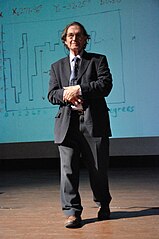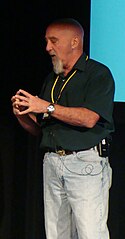Orchestrated objective reduction (Orch OR) is a highly controversial theory postulating that consciousness originates at the quantum level inside neurons (rather than being a product of neural connections). The mechanism is held to be a quantum process called objective reduction that is orchestrated by cellular structures called microtubules. It is proposed that the theory may answer the hard problem of consciousness and provide a mechanism for free will.[1] The hypothesis was first put forward in the early 1990s by Nobel laureate for physics Roger Penrose, and anaesthesiologist Stuart Hameroff. The hypothesis combines approaches from molecular biology, neuroscience, pharmacology, philosophy, quantum information theory, and quantum gravity.[2][3]
While more generally accepted theories assert that consciousness emerges as the complexity of the computations performed by cerebral neurons increases,[4][5] Orch OR posits that consciousness is based on non-computable quantum processing performed by qubits formed collectively on cellular microtubules, a process significantly amplified in the neurons. The qubits are based on oscillating dipoles forming superposed resonance rings in helical pathways throughout lattices of microtubules. The oscillations are either electric, due to charge separation from London forces, or magnetic, due to electron spin—and possibly also due to nuclear spins (that can remain isolated for longer periods) that occur in gigahertz, megahertz and kilohertz frequency ranges.[2][6] Orchestration refers to the hypothetical process by which connective proteins, such as microtubule-associated proteins (MAPs), influence or orchestrate qubit state reduction by modifying the spacetime-separation of their superimposed states.[7] The latter is based on Penrose's objective-collapse theory for interpreting quantum mechanics, which postulates the existence of an objective threshold governing the collapse of quantum states, related to the difference of the spacetime curvature of these states in the universe's fine-scale structure.[8]
Orchestrated objective reduction has been criticized from its inception by mathematicians, philosophers,[9][10][11][12][13] and scientists.[14][15][16] The criticism concentrated on three issues: Penrose's interpretation of Gödel's theorem; Penrose's abductive reasoning linking non-computability to quantum events; and the brain's unsuitability to host the quantum phenomena required by the theory, since it is considered too "warm, wet and noisy" to avoid decoherence.
- ^ Hameroff, Stuart (2012). "How quantum brain biology can rescue conscious free will". Frontiers in Integrative Neuroscience. 6: 93. doi:10.3389/fnint.2012.00093. PMC 3470100. PMID 23091452.
- ^ a b Hameroff, Stuart; Penrose, Roger (2014). "Reply to seven commentaries on "Consciousness in the universe: Review of the 'Orch OR' theory"". Physics of Life Reviews. 11 (1): 94–100. Bibcode:2014PhLRv..11...94H. doi:10.1016/j.plrev.2013.11.013.
- ^ Penrose, Roger (2014). "On the Gravitization of Quantum Mechanics 1: Quantum State Reduction". Foundations of Physics. 44 (5): 557–575. Bibcode:2014FoPh...44..557P. doi:10.1007/s10701-013-9770-0. S2CID 123379100.
- ^ McCulloch, Warren S.; Pitts, Walter (1943). "A logical calculus of the ideas immanent in nervous activity". Bulletin of Mathematical Biophysics. 5 (4): 115–133. doi:10.1007/bf02478259.
- ^ Hodgkin, Alan L.; Huxley, Andrew F. (1952). "A quantitative description of membrane current and its application to conduction and excitation in nerve". Journal of Physiology. 117 (4): 500–544. doi:10.1113/jphysiol.1952.sp004764. PMC 1392413. PMID 12991237.
- ^ Hameroff, Stuart; Penrose, Roger (2014). "Reply to criticism of the 'Orch OR qubit' – 'Orchestrated objective reduction' is scientifically justified". Physics of Life Reviews. 11 (1): 104–112. Bibcode:2014PhLRv..11..104H. doi:10.1016/j.plrev.2013.11.014.
- ^ Hameroff, Stuart; Penrose, Roger (2014). "Consciousness in the universe". Physics of Life Reviews. 11 (1): 39–78. Bibcode:2014PhLRv..11...39H. doi:10.1016/j.plrev.2013.08.002. PMID 24070914.
- ^ Natalie Wolchover (31 October 2013). "Physicists Eye Quantum-Gravity Interface". Quanta Magazine (Article). Simons Foundation. Retrieved 19 March 2014.
- ^ Boolos, George; et al. (1990). "An Open Peer Commentary on The Emperor's New Mind". Behavioral and Brain Sciences. 13 (4): 655. doi:10.1017/s0140525x00080687. S2CID 144905437.
- ^ Davis, Martin (September 1993). "How subtle is Gödel's theorem? More on Roger Penrose". Behavioral and Brain Sciences. 16 (3): 611–612. doi:10.1017/S0140525X00031915. S2CID 144018337.
- ^ Lewis, David (July 1969). "Lucas against Mechanism". Philosophy. 44 (169): 231–233. doi:10.1017/s0031819100024591. S2CID 170411423.
- ^ Putnam, Hilary (1 July 1995). "Book Review: Shadows of the mind". Bulletin of the American Mathematical Society. 32 (3): 370–374. doi:10.1090/S0273-0979-1995-00606-3.
- ^ Putnam, Hilary (20 November 1994). "The Best of All Possible Brains?". The New York Times.
- ^ Tegmark, Max (2000). "Importance of quantum decoherence in brain processes". Physical Review E. 61 (4): 4194–4206. arXiv:quant-ph/9907009. Bibcode:2000PhRvE..61.4194T. doi:10.1103/PhysRevE.61.4194. PMID 11088215. S2CID 17140058.
- ^ Koch, Christof; Hepp, Klaus (2006). "Quantum mechanics in the brain". Nature. 440 (7084): 611. Bibcode:2006Natur.440..611K. doi:10.1038/440611a. PMID 16572152. S2CID 5085015.
- ^ Hepp, K. (September 2012). "Coherence and decoherence in the brain". Journal of Mathematical Physics. 53 (9): 095222. Bibcode:2012JMP....53i5222H. doi:10.1063/1.4752474.

